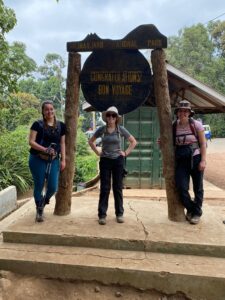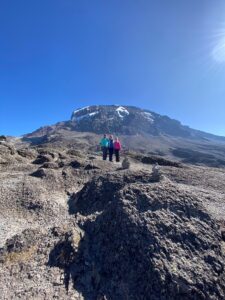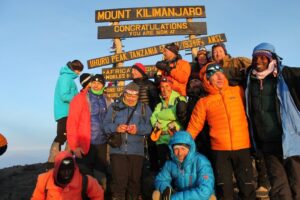
Small Groups.

Secured
Payments

Local Guides.

Easy Payments
About Kilimanjaro Mountain.
Conquer the majestic Kilimanjaro! Embark on a thrilling expedition to Africa’s highest peak, where breathtaking views and exhilarating challenges await.
Our experienced guides will lead you through the awe-inspiring landscapes, ensuring your safety and creating unforgettable memories. Prepare for the adventure of a lifetime on Kilimanjaro!
Start With us?
Kilimanjaro Mountain:Preparation
Pre-Climb Medical Check Up
All aspiring Mount Kilimanjaro climbers should have a medical check prior to their climb. Specifically ask your doctor about high altitude climbing for your age, fitness level, and overall health. Ask if any of your pre-existing medical conditions are likely to cause problems while you’re on the mountain, and if any of your medications might interfere with your acclimatization. Ask if it is possible to take Diamox with any of your current medications.
It is best to find this entire out before booking your climbing trek!
Medical conditions such as spinal issues, circulation problems, diabetes, hypoglycemia, intestinal or kidney problems, asthma, high or low blood pressure, head trauma, heart conditions, cancer, seizure disorders, blood disease, dislocations, hernias, and sprains may make climbing Mount Kilimanjaro dangerous or even impossible. It is crucial that you consult your doctor about any pre-existing conditions.
The minimum age for climbing Kilimanjaro is 10. While there is no maximum age, it is important to remember that it is a physically demanding trek. Climbers under 18 and over 60 should consult with their doctor to see whether climbing Kilimanjaro is for them. Your resting heart rate should be lower than 100 beats per minute to attempt the climb. If it is higher than this, you’ll need to receive a doctor’s approval prior to attempting the climb.
Training to Climb Mount Kilimanjaro
While it is often said that Mount Kilimanjaro is an ‘easy’ mountain to climb, you should not underestimate just how physically demanding the climb can be. While Mount Kilimanjaro offers better climbing conditions than many mountains around the world, this does not mean that the climb itself is not intensely demanding.
It is important that you not only be physically and aerobically fit for your climb, but also mentally prepared for the strain as well.
There is no ideal body shape or level of fitness for climbing Kilimanjaro. We’ve seen marathon runners succumb to altitude sickness while less physically fit individuals have made it all the way to the top. Our advice is to get into the best hiking shape you can. While it is impossible to predict exactly how your body will react to conditions on the mountain, you can certainly prepare to minimize your chances of being defeated by the cold, the physical demands, or the altitude.
Put simply: the best way to prepare to hike up Mount Kilimanjaro is to hike. While many tour operators will recommend needlessly complicated training regimens for you to adhere to, you can prepare adequately for climbing Kilimanjaro by simply practicing the skills you’ll need on the mountain. If possible, spend as much time as possible hiking on hills or mountains to train your cardiovascular system and your legs.
Day hikes are a great exercise.
If you don’t have access to outdoor trails and such, stair masters in the gym can be used to simulate the physical demands of climbing the mountain. If you don’t have access to trails or a gym, just start walking as much and as often as possible.
Your training should start at least two months before your climb
If you’ve not hiked before, it’s best to start your training with a slow pace, shorter time intervals, and no weight in your day pack. As your fitness improves, you can increase all of the above gradually. It is important to remember that while climbing Mount Kilimanjaro, you will be walking for long amounts of time at a slow space and will rarely be carrying more than 10 kilograms. It isn’t a race, and your training should reflect this.
Gradually increase the length of your hikes and the weight in your pack rather than worrying about pace. You should aim to train three days a week for a minimum of one hour. If you’re able to do day hikes of 4 to 6 hours with moderate elevation changes and 10kgs in your day pack, then you’re probably ready to go. You should save your longest and hardest workouts for the four weeks prior to your departure, and should taper things off in the two weeks immediately before your climb. Your body needs time to rest and restore energy before you begin your climb. You may also wish to supplement your hiking training with swimming, cycling, or jogging to increase your aerobic fitness.
It is important that you wear the boots you intend to climb in during your training and carry the pack you intend to use. You will need time to break in your boots and get used to the weight and points of contact of your pack, and the best way to do this is to train with both! While the physical training is an important part of getting into climbing shape, it is not the only part.
You should see your Mount Kilimanjaro climb as an opportunity to make positive changes in your own life. Eat more fruits and vegetables, quit smoking, reduce your alcohol intake, get eight hours of sleep a night, reduce your stress levels, and reduce your red meat consumption. You’ll feel better for it!
Our Happy Clients!
Our Tanzania trip was fabulous. Spotting the Tree-climbing lions and Black Rhino was unforgettable. Thanks for fulfilling our dreams. We’ll be back soon!

Clara Smith
Thank you, Maasai Land Wonders Team, for your exceptional care during my 3 Months Volunteering program. A thousand thanks for an unforgettable experience.

Shelly Barns
Thank you, Edwin and your team, for an amazing 7-day trip. Your personal care and dedication made it unforgettable. 1000 thanks!

Jacob Luke
Contact us, We're at your Service.








Trusted by:

